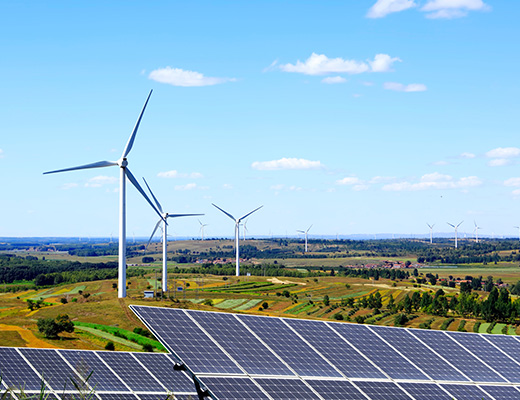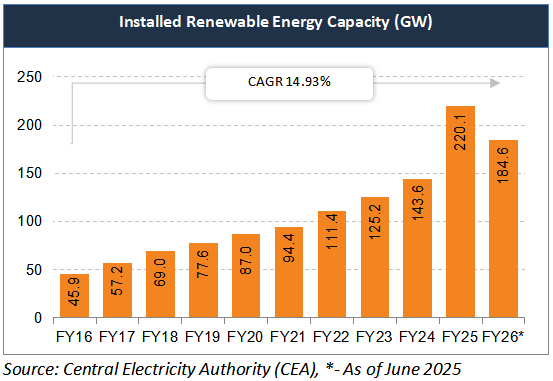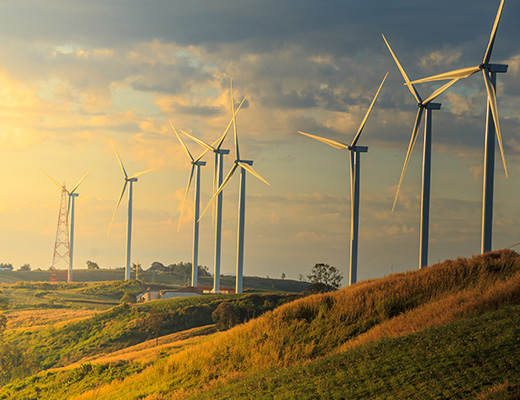Advantage India
Robust
Demand
*Ministry of New and Renewable Energy targets 500 GW non-fossil-based electricity generation by 2030, as per the Prime Minister's COP26 announcement, with an added installation of 13.5 GW renewable energy capacity in 2023, corresponding to an investment of around Rs. 74,000 crores (US$ 8.90 billion).
*India’s Rs. 9,22,866 crore (US$ 109.50 billion) plan aims to expand power infrastructure, meet 458 GW demand by 2032, enhance transmission, integrate renewable energy, and boost energy security, unlocking vast untapped potential.
*India’s renewable energy sector witnessed a remarkable 420% YoY surge in capacity addition in June 2025, growing from 1.4 gigawatt (GW) in June 2024 to 7.3 GW this year.
Increasing
Investments
*Indian conglomerates plan to invest Rs. 67,42,400 crore (US$ 800 billion) in green hydrogen, clean energy, semiconductors, and EVs by 2034.
*According to Union Minister for New and Renewable Energy, Mr. Pralhad Joshi, India attracted Rs. 42,000 crore (US$ 4.88 billion) in clean energy Foreign Direct Investment (FDI) in 2023 alone, contributing to a cumulative FDI inflow of over Rs. 1,60,000 crore (US$ 18.60 billion) since 2020. In Q1 2025, clean energy investments soared 7.7 times YoY to Rs. 84,309 crore (US$ 9.8 billion).
Policy
Support
*On September 30, 2024, The Rajasthan government signed an MoU with NTPC Green Energy for 28,500 MW of renewable energy-based projects, as part of the total 31,825 MW of power generation projects worth Rs. 1.6 lakh crore (US$ 19.18 billion). This massive renewable energy investment is aimed at making Rajasthan self-reliant in the energy sector and significantly expanding the state's renewable power capacity.
*On August 05, 2025, Hindustan Power has signed a power purchase agreement with Uttar Pradesh Power Corporation Ltd. to set up a 435 MW DC solar power project. The project will supply clean electricity to the state for 25 years, aligning with Uttar Pradesh’s target of achieving 22,000 MW of clean energy capacity by 2026-27.
Competitive
Advantage
*India continues to rank fourth globally in wind power capacity, solar power capacity, and overall renewable energy installed capacity as of FY25, maintaining its position from FY24.
*Power generation from solar and wind projects are likely to be cost-competitive relative to thermal power generation in India in 2025-30.
*India has officially surpassed Japan to become the world's third-largest solar energy producer. According to data from the International Renewable Energy Agency (IRENA), India generated 1,08,494 GWh of solar power, exceeding Japan's 96,459 GWh.
Renewable Energy Hubs
- Rajasthan
- Gujarat
- Andhra Pradesh
- Karnataka
- Telangana
- Tamil Nadu

Posters
MORE
TAKING THE CLEAN ROUTE
India is the fourth most attractive country on the renewable energy index globally.
IBEF Campaigns
MORE
Aatmanirbhar Bharat Utsav 2024
Union Minister of External Affairs, Dr. S. Jaishankar and Union Commerce an...
Case Studies
MOREIBEF BLOG
MORERevival of India’s Forgotten Superfoods: Jackfruit, Amaranth and Moringa in Global Diets
For centuries, Indian kitchens have been home to an incredible diversity of...
Next-Gen GST: Powering India’s Investment and Demand Surge
India’s recent Goods and Services Tax (GST) overhaul is more than a s...
Transforming Spaces: The Growth and Opportunities in India’s Home Décor Industry
India’s home décor industry is evolving into one of the most d...














